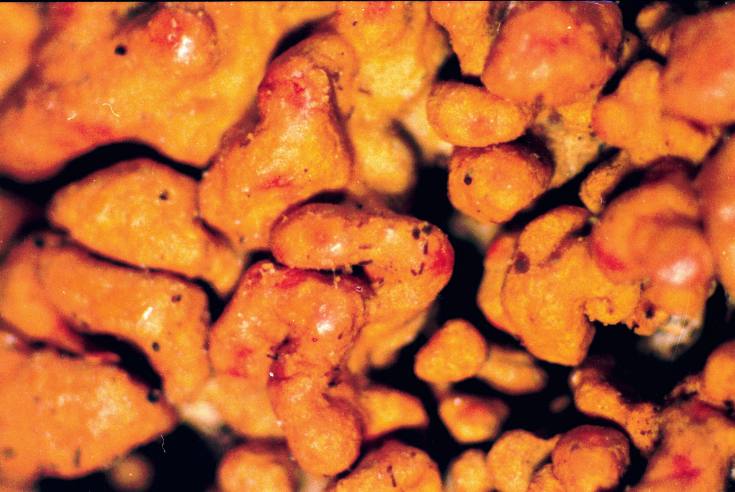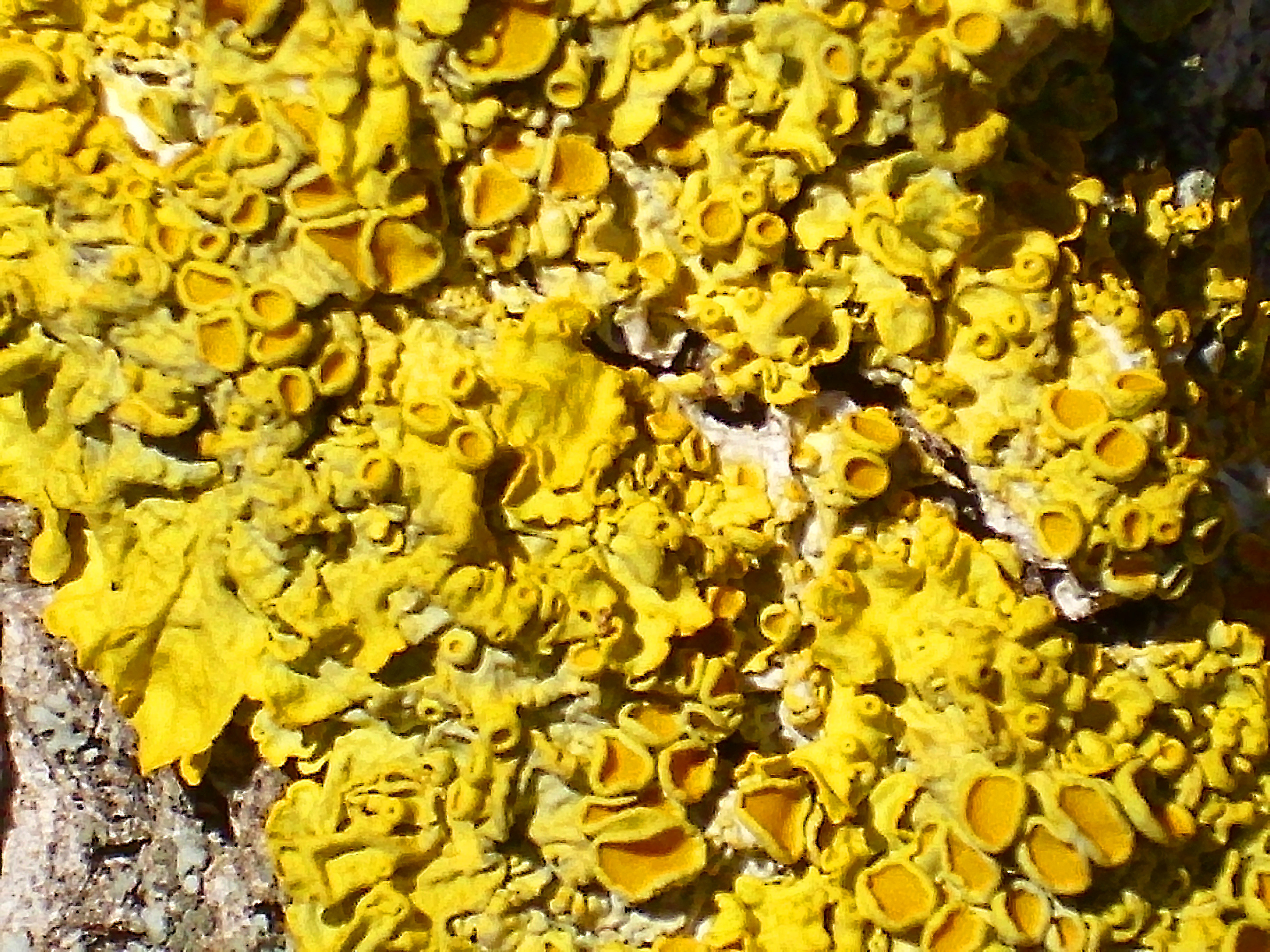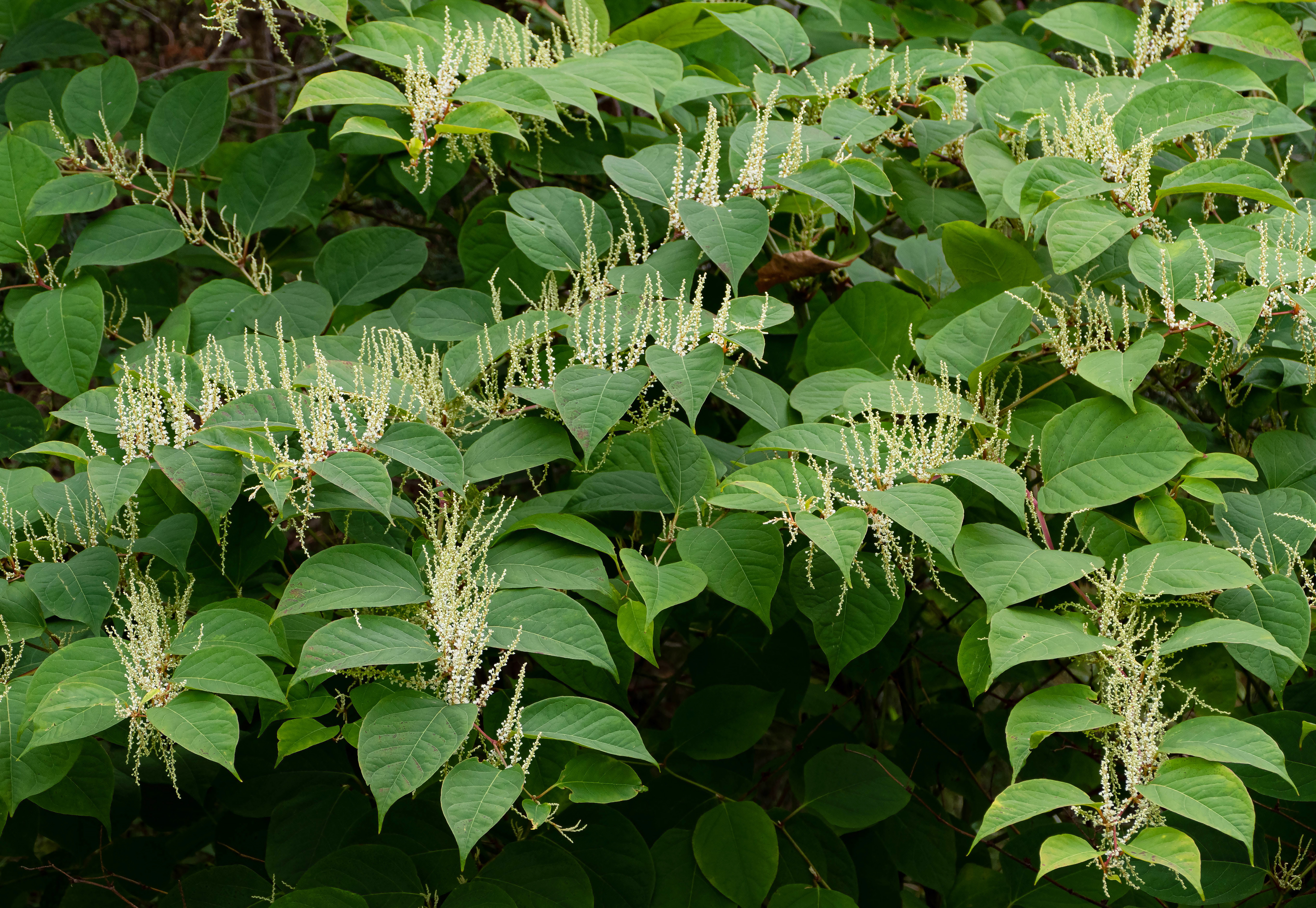|
Zeroviella Esfahanensis
''Zeroviella esfahanensis'' is a species of saxicolous (rock-dwelling) foliose lichen in the family Teloschistaceae. It is found in various locations across the Palearctic realm, having been recorded in Europe, Asia, and North Africa, where it grows in alpine and cold desert areas. Taxonomy ''Zeroviella esfahanensis'' was described by Sergey Kondratyuk, Behrouz Zarei-Darki, and Jae-Seoun Hur. Its species epithet is derived from the Esfahan Province in Iran, where the type specimen was collected. Its location specifics are Esfahan Province, roughly south of Tehran, near the outskirts of the Natanz settlement within the Karkas hunting-prohibited Region, at an altitude of . Molecular studies have shown that the taxonomic position of ''Zeroviella esfahanensis'' remains somewhat uncertain. While certain genetic markers suggest it belongs to the ''Zeroviella'' group, others place it within ''Rusavskia''. Description This lichen has a foliose thallus, often resembling a ... [...More Info...] [...Related Items...] OR: [Wikipedia] [Google] [Baidu] |
Saxicolous Lichen
A saxicolous lichen is a lichen that grows on rock. The prefix "sax" from the Latin means "rock" or "stone". Characteristics Saxicolous lichens exhibit very slow growth rates. They may develop on rock substrates for long periods of time, given the absence of external disturbances. The importance of the mineral composition of the rock substrate, as well as the elemental geochemistry Geochemistry is the science that uses the tools and principles of chemistry to explain the mechanisms behind major geological systems such as the Earth's crust and its oceans. The realm of geochemistry extends beyond the Earth, encompassing the e ... is also important to the distribution of saxicolous lichens, but the relationship between the substrate influence on lichens, either chemical or textural, is still obscure. Communities of saxicolous lichens are often species-rich in terms of number. References Lichenology {{lichen-stub ... [...More Info...] [...Related Items...] OR: [Wikipedia] [Google] [Baidu] |
Apothecia
An ascocarp, or ascoma (), is the fruiting body ( sporocarp) of an ascomycete phylum fungus. It consists of very tightly interwoven hyphae and millions of embedded asci, each of which typically contains four to eight ascospores. Ascocarps are most commonly bowl-shaped (apothecia) but may take on a spherical or flask-like form that has a pore opening to release spores (perithecia) or no opening (cleistothecia). Classification The ascocarp is classified according to its placement (in ways not fundamental to the basic taxonomy). It is called ''epigeous'' if it grows above ground, as with the morels, while underground ascocarps, such as truffles, are termed ''hypogeous''. The structure enclosing the hymenium is divided into the types described below (apothecium, cleistothecium, etc.) and this character ''is'' important for the taxonomic classification of the fungus. Apothecia can be relatively large and fleshy, whereas the others are microscopic—about the size of flecks of ... [...More Info...] [...Related Items...] OR: [Wikipedia] [Google] [Baidu] |
Caloplaca Vorukhica
''Caloplaca'' is a lichen genus comprising a number of distinct species. Members of the genus are commonly called firedot lichen, jewel lichen.Field Guide to California Lichens, Stephen Sharnoff, Yale University Press, 2014, gold lichens, "orange lichens", but they are not always orange, as in the case of '' C. albovariegata''. The distribution of this lichen genus is worldwide, extending from Antarctica to the high Arctic. It includes a portion of northern North America and the Russian High Arctic. There are about thirty species of ''Caloplaca'' in the flora of the British Isles. An example species in this genus is '' Caloplaca saxicola'', a lichen with worldwide distribution including the Antarctic continent, Europe and northern North America including the northern reaches of the Canadian boreal forests. A new species of ''Caloplaca'', '' C. obamae'', the first species to be named in honor of Barack Obama, was discovered in 2007 on Santa Rosa Island in California a ... [...More Info...] [...Related Items...] OR: [Wikipedia] [Google] [Baidu] |
Rusavskia Elegans
''Rusavskia elegans'' (formerly ''Xanthoria elegans''), commonly known as the elegant sunburst lichen, is a lichenized species of fungus in the genus ''Rusavskia'', family Teloschistaceae. Recognized by its bright orange or red pigmentation, this species grows on rocks, often near bird or rodent perches. It has a circumpolar and alpine distribution. It was one of the first lichens to be used for the rock-face dating method known as lichenometry. Taxonomy ''Rusavskia elegans'' was first formally described by Johann Heinrich Friedrich Link as ''Lichen elegans'' in 1791, and transferred to the genus ''Xanthoria'' by Theodor Magnus Fries (son of Elias Magnus Fries) in 1860. In 2003, Sergey Kondratyuk and Ingvar Kärnefelt transferred the taxon to their newly circumscribed genus ''Rusavskia'', in which it is the type species. Although the new genus was not initially widely accepted, subsequent molecular phylogenetic studies showed the validity of the new classification. Description ... [...More Info...] [...Related Items...] OR: [Wikipedia] [Google] [Baidu] |
Septum
In biology, a septum (Latin for ''something that encloses''; plural septa) is a wall, dividing a cavity or structure into smaller ones. A cavity or structure divided in this way may be referred to as septate. Examples Human anatomy * Interatrial septum, the wall of tissue that is a sectional part of the left and right atria of the heart * Interventricular septum, the wall separating the left and right ventricles of the heart * Lingual septum, a vertical layer of fibrous tissue that separates the halves of the tongue. *Nasal septum: the cartilage wall separating the nostrils of the nose * Alveolar septum: the thin wall which separates the alveoli from each other in the lungs * Orbital septum, a palpebral ligament in the upper and lower eyelids * Septum pellucidum or septum lucidum, a thin structure separating two fluid pockets in the brain * Uterine septum, a malformation of the uterus * Vaginal septum, a lateral or transverse partition inside the vagina * Intermuscular sep ... [...More Info...] [...Related Items...] OR: [Wikipedia] [Google] [Baidu] |
Zeroviella Mandschurica
''Zeroviella'' is a genus of lichen-forming fungi in the subfamily Xanthorioideae of the family Teloschistaceae. It has eight saxicolous (rock-dwelling) species. ''Zeroviella'' was segregated from ''Rusavskia'', a closely related genus, in 2015. Taxonomy The genus was circumscribed by lichenologists Sergey Kondratyuk and Jae-Seoun Hur in 2015, to contain the species complex centred around ''Rusavskia papillifera''. Accordingly, ''Zeroviella papillifera'' was assigned as the type species of the genus. According to their phylogenetic analysis, these species formed a monophyletic branch, warranting distinction as a new genus. Members of the genus ''Zeroviella'' exhibit distinct differences from those of the genus ''Rusavskia''. Notably, ''Zeroviella'' has cortical layers throughout the thallus, in contrast to ''Rusavskia'', which primarily features tissue with only a slight paraplectenchymatous layer. Additionally, the s of ''Zeroviella'' are noticeably thinner, attributed ... [...More Info...] [...Related Items...] OR: [Wikipedia] [Google] [Baidu] |
Emodin
Emodin (6-methyl-1,3,8-trihydroxyanthraquinone) is a chemical compound, of the anthraquinone family, that can be isolated from rhubarb, buckthorn, and Japanese knotweed (''Reynoutria japonica'' syn. ''Polygonum cuspidatum''). Emodin is particularly abundant in the roots of the Chinese rhubarb (Rheum palmatum), knotweed and knotgrass (Polygonum cuspidatum and multiflorum) as well as Hawaii ‘au‘auko‘i cassia seeds or coffee weed (Semen cassia). It is specifically isolated from Rheum palmatum L. It is also produced by many species of fungi, including members of the genera ''Aspergillus'', ''Pyrenochaeta'', and ''Pestalotiopsis'', inter alia. The common name is derived from ''Rheum emodi'', a taxonomic synonym of ''Rheum australe'', (Himalayan rhubarb) and synonyms include emodol, frangula emodin, rheum emodin, 3-methyl-1,6,8-trihydroxyanthraquinone, Schüttgelb (Schuttgelb), and Persian Berry Lake. Pharmacology Emodin is an active component of several plants used in Traditiona ... [...More Info...] [...Related Items...] OR: [Wikipedia] [Google] [Baidu] |
Parietinic Acid
Parietinic acid is an organic compound in the structural class of chemicals known as anthraquinones. It is found in many species of the lichen family Teloschistaceae. The substance was first reported in the literature by the German chemist Walter Eschrich in 1958. Occurrence Originally isolated from the lichen ''Xanthoria parietina'', it has since been identified in many lichens of the family Teloschistaceae. In 1970, Johan Santesson proposed a possible biogenetic relationship between the anthraqunone compounds commonly found in ''Caloplaca''. According to this scheme, emodin is methylated to give parietin, which then undergoes three successive oxidations, sequentially forming fallacinol, fallacinal, and then parietinic acid. A is a set of biosynthetically related compounds produced by a lichen. In 2002, Ulrik Søchting and Patrik Frödén identified chemosyndrome A, the most common chemosyndrome in the genus ''Teloschistes'' and in the entire family Teloschistaceae, whic ... [...More Info...] [...Related Items...] OR: [Wikipedia] [Google] [Baidu] |
Fallacinal
Fallacinal is an organic compound in the structural class of chemicals known as anthraquinones. It is found in many species of the lichen family Teloschistaceae. History In 1936, Japanese chemists Mitizo Asano and Sinobu Fuziwara reported on their investigations into the colour pigments of the lichen ''Xanthoria fallax'' (now known as ''Oxneria fallax''), found growing on the bark of mulberry trees. They isolated a biological pigment, pigment they named fallacin. A few years later Asano and Yosio Arata further purified the crude material from this lichen, ultimately obtaining an orange-yellow compound with a molecular formula of C16H12O6. Using information from additional chemical tests, they proposed a tentative structural formula for fallacin. In 1949, T. R. Seshadri and S. Subramanian described their work with the Indian lichen ''Teloschistes flavicans'', in which they isolated an orange substance they named teloschistin, and which had a structural formula identical to that of ... [...More Info...] [...Related Items...] OR: [Wikipedia] [Google] [Baidu] |
Teloschistin
Fallacinol (teloschistin) is an organic compound in the structural class of chemicals known as anthraquinones. It is found in some lichens, particularly in the family Teloschistaceae, as well as a couple of plants and non lichen-forming fungi. In 1936, Japanese chemists isolated a pigment named fallacin from the lichen ''Oxneria fallax'', which was later refined and assigned a tentative structural formula; by 1949, Indian chemists had isolated a substance from ''Teloschistes flavicans'' with an identical structural formula to fallacin. Later research further separated fallacin into two distinct pigments, fallacin-A (later called fallacinal) and fallacin-B (fallacinol). The latter compound is also known as teloschistin due to its structural match with the substance isolated earlier. History In 1936, Japanese chemists Mitizo Asano and Sinobu Fuziwara reported on their chemical investigations into the colour pigments of the lichen ''Xanthoria fallax'' (now known as ''Oxneria fallax'' ... [...More Info...] [...Related Items...] OR: [Wikipedia] [Google] [Baidu] |
Parietin
Parietin is the predominant cortical pigment of lichens in the genus '' Caloplaca'', a secondary product of the lichen ''Xanthoria parietina'', and a pigment found in the roots of Curled Dock (''Rumex crispus''). It has an orangy-yellow color and absorbs blue light. It is also known as physcion. It has also been shown to protect lichens against UV-B light, at high altitudes in Alpine regions. The UV-B light stimulates production of parietin and the parietin protects the lichens from damage. Lichens in arctic regions such as Svarlbard retain this capability though they do not encounter damaging levels of UV-B, a capability that could help protect the lichens in case of Ozone layer thinning. It has also shown anti-fungal activity against barley powdery mildew and cucumber powdery mildew, more efficiently in the latter case than treatments with fenarimol and polyoxin B. It reacts with KOH to form a deep, reddish-magenta compound. Effect on human cancer cells Also found in rhu ... [...More Info...] [...Related Items...] OR: [Wikipedia] [Google] [Baidu] |
Spot Test (lichen)
A spot test in lichenology is a spot analysis used to help identify lichens. It is performed by placing a drop of a chemical on different parts of the lichen and noting the colour change (or lack thereof) associated with application of the chemical. The tests are routinely encountered in dichotomous keys for lichen species, and they take advantage of the wide array of lichen products produced by lichens and their uniqueness among taxa. As such, spot tests reveal the presence or absence of chemicals in various parts of a lichen. They were first proposed by the botanist William Nylander in 1866. Three common spot tests use either 10% aqueous KOH solution (K test), saturated aqueous solution of bleaching powder or calcium hypochlorite (C test), or 5% alcoholic ''p''-phenylenediamine solution (P test). The colour changes occur due to presence of particular secondary metabolites in the lichen. There are several other less frequently used spot tests of more limited use that are employed ... [...More Info...] [...Related Items...] OR: [Wikipedia] [Google] [Baidu] |



